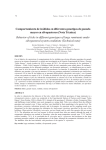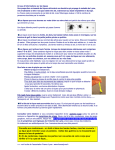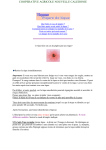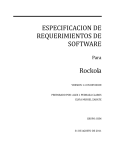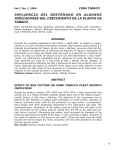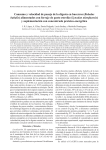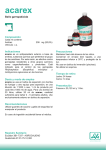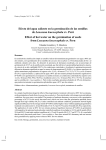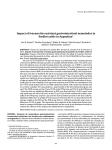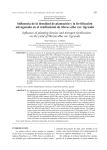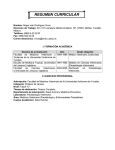Download 1.1 Nota Editorial.pmd
Transcript
77 Pastos y Forrajes, Vol. 36, No. 1, January-March, 77-81, 2013 Behavior of ticks in different genotypes of large ruminants under silvopastoral system conditions (Technical Note) Kirenia Hernández, J. Arece, L. Simón, L. Hernández y O. Valdés Estación Experimental de Pastos y Forrajes “Indio Hatuey”, Universidad de Matanzas “Camilo Cienfuegos”, Ministerio de Educación Superior Central España Republicana. CP 44280. Matanzas. Cuba E-mail: [email protected] ABSTRACT In order to characterize the behavior of the ticks which affect different genotypes of large ruminants in a silvopastoral system, a study was conducted at the Experimental Station of Pastures and Forages “Indio Hatuey”, from October, 2010, to March, 2011. Animals of the genotypes F1 (Holstein x Zebu), Commercial Zebu and Buffalypso (water buffalo) were used, managed as a unique herd. Ticks were collected from the different genotypes and counted, every 15 days, and they were identified by their morphology to the species level. The prevalence, extension, infestation intensity and its dynamics, by genotype and by sampling month were determined. In the three genotypes the infestation by Amblyomma cajennense prevailed. In the case of the buffaloes, Rhipicephalus (Boophilus) microplus was not found, and in cattle this parasite did not exceed 29 %. The infestation rate was low because it did not exceed three ticks per animal; although the peak of ectoparasite infestation was reached in December, when the mean temperature records were 17,1ºC and the relative humidity, 79 %. It is concluded that R. microplus and A. cajennense had incidence on the large ruminant genotypes studied, with predominance of the latter, although the ectoparasite infestation was low. The buffaloes were the least infested, with prevalence of the species A. cajennense. Key words: large ruminants, Ixodidae, silvopastoral system INTRODUCTION The main objective of animal production systems is to maximize the productive efficiency of livestock to obtain a higher economic benefit. Nevertheless, cattle exploitation is limited by different factors, such as: management, feeding, genetics, health status and climate effects; they are related among themselves and the limitations or affectations of one of them prevents good production (Zenteno, Morales, Rivera and Barba, 2000). In addition, in the case of grazing animals, parasite infestations also constitute one of the most common factors which limit productions (Álvarez, 2005). In tropical and subtropical countries, one of the main economic problems in cattle production are ticks, due to the parasite action they exert on the host, the diseases they transmit (Horak, Golezardy and Uys, 2006; Rodríguez et al., 2006) and the problems caused by their chemical control (Jonsson, Mayer and Green, 2000). In this sense, in America there is a wide distribution of different tick species, which vary according to the climate conditions and the presence of hosts that facilitate their establishment, because they are generally parasites of the wild fauna (Nari, 1995). The utilization of breeds or crossings more resistant to ticks is one of the methods that reduce these populations in the animals. The Zebu cattle and some autochthonous African and American breeds are naturally immune to ticks (Junquera, 2007), contrary to the European cattle (Bos taurus), for which the best way to avoid such problem is to promote breeds with this immunity; nevertheless, due to productivity demands, the trend in many regions goes in the inverse direction (Junquera, 2007). The population dynamics of ticks in silvopastoral systems has not been deeply studied. It is said that their microclimate conditions could favor the survival of Ixodidae and directly influence their reproduction and survival (Guglielmone, Mangold, Aguirre and Gaido, 1990). In other studies this type of systems has been compared to natural pastures and no differences have been found in the population peaks of ticks (Mangold, Aguirre, Gaido and Guglielmone,1994). That is why 78 Pastos y Forrajes, Vol. 36, No. 1, January-March, 77-81, 2013 the objective of this work was to characterize the behavior of ticks which affect different genotypes of large ruminants in a silvopastoral system. MATERIALSAND METHODS Location. The research was conducted in the silvopastoral system of the Experimental Station of Pastures and Forages “Indio Hatuey”, in Matanzas province, Cuba, from November, 2010, to March, 2011. Climate and soil. The mean temperature of the experimental period was 26,01ºC; relative humidity, 78%; cumulative rainfall, 243,3 mm; and evaporation, 155,5 mm. The soil is classified as lixiviated Ferralitic Red (Hernández et al., 1999), of plain topography. According to Mesa and Suárez (1986), it is latosolic, with good drainage and moderate fertility. Animals. Thirty animals were used: 10 F1 (Holstein x Zebu), 10 Commercial Zebu and 10 Buffalypso (water buffalo), 20 months old as average, and with a weight of 259,6 kg; 280,3 kg and 298,3 kg for each genotype, respectively. They showed good health status and were not immunized with GAVAC®. Grazing system. The silvopastoral system used had been under exploitation for 20 years and was composed by Leucaena leucocephala cv. Cunningham, with an average density of 400 trees/ha, and by Panicum maximum cv. Likoni as base pasture. The stocking rate was 1,8 AU/ha as average. Pruning was applied in a gradual way, in the dry season (DS), at a height of 150 cm. Measurements. The left side of the animal was meticulously examined, through the inspection and feeling method (Centro Nacional de Parasitología, 2002). The ticks were counted every 15 days and 100 were collected, whose size exceeded 4 mm, which coincides with the methodology used by Obregón, Rodríguez, Roque and Alemán (2010). For their classification the taxonomic elements described by Soulsby (1988), the size of the hypostome, the shape of the spiracles, the size of the palpi and the presence of festoons, adanal plaques and eyes, were taken into consideration. Statistical analysis. The relative appearance prevalence of ticks in the animals of each genotype was determined and a comparison of proportions was made, to determine the differences in this indicator. The differences among means were established through the multiple range comparison test by Duncan (1955) and any value of P<0,05 was considered significant. The statistical pack SPSS ® version 15.0 for Windows® was used. RESULTS AND DISCUSSION When classifying the ticks they were determined to correspond to the species A. cajennense and R. microplus, in agreement with the morphological characteristics described by Soulsby (1988). In the three genotypes there was predominance of infestation by A. cajennense. In the buffaloes R. microplus was not found and in the cattle this parasite did not exceed 29 %. Such results differ from the ones reported by Obregón et al. (2010), who found that 100% of the specimens collected in buffaloes belonged to the species R. microplus. The two Ixodidae species found in the genotypes are in correspondence with the ones with higher economic importance in production systems of large ruminants in Cuba (Centro Nacional de Parasitología, 2002). Table 1 shows the prevalence of infestation per animal genotype. Pérez (2010) found similar results, when reporting a predominance of R. microplus (92,3 %) over A. cajennense (7,7 %) in grazing dairy cows at the Experimental Station of Pastures and Forages “Indio Hatuey”. Also, in Mexico, Cabrera et al. (2003) found higher incidence of R. microplus ticks in cattle as compared with A. cajennense. The absolute presence of A. cajennense in the buffaloes could be related to the influence of several factors, among which the predominance and adaptability (plasticity) of this ixode to several conditions and hosts stand out, because it has been reported in different species such as sheep, horses and pigs, mainly within the ears and in other natural cavities, but also in the flanks, the withers, the horsehair and the tail (Strickland, Gerrish, Hourrigan and Schubert, 1976). In addition, it can parasite man, by being fixed between the legs or on the abdomen (Barriga, 1994). Table 1. Prevalence (%) of tick infestation by genotype. Genotype F1 Commercial Zebu Bufalypso Total R. microplus Quantity Prevalence 15 27,2 10 28,5 25 25 A. cajennense Quantity Prevalence 40 72,8 25 71,5 10 100 75 75 Total 55 35 10 100 79 Pastos y Forrajes, Vol. 36, No. 1, January-March, 77-81, 2013 The hypostome (organ in charge of fixating and feeding) constitutes a decisive element in the ectoparasitism of Ixodidae (Rodríguez et al., 2006). R. microplus has a shorter hypostome than A. cajennense and to become implanted it must overcome some barriers of the host, such as: hair type, skin thickness, capillarization and density of the sweat and sebaceous glands, which offer resistance. These characteristics are stressed in buffaloes and create a physiological barrier to the ectoparasite implantation of R. microplus (Obregón et al., 2010). In addition to the above-mentioned factors, buffaloes use to roll over and over and cover themselves with mud in the wallowing places created in the resting areas. García, Planas, López and Rodríguez (2010) express that buffaloes are very resistant to parasitic diseases, and that this behavior helps to eliminate ectoparasites. Another possible phenomenon is related to the natural resistance of the animals against ticks from the genetic point of view. Holstein cattle has in its genome a reduced number of tick-resistance carrier alleles, for which their hereditary transmission is low as compared with other animal breeds (Porto, Jonson and Barendse, 2011). In addition, in studies conducted by Villar (2006) the ectoparasite resistance of the Zebu cattle has proven to be highly heritable (80 %), which constitutes a possible cause of the presence of low infestation rates in this genotype. Figure 1 shows the infestation dynamics of Ixodidae in the three studied genotypes. The infestation rate in the three groups was low, because it did not exceed three ticks per animal. The highest peak of ectoparasite infestation was reached in December, when the mean temperature records were 17,1ºC and the relative humidity was 79 %. Since that moment the temperatures had a slight increase and the quantity of recovered ticks was stabilized until the end of the study. These results differ from the ones reported by Guglielmone et al. (1990), who stated that the ideal temperature for tick survival is 27-39ºC and the relative humidity, 60-80 %. Figure 2 shows the average tick count in the animal genotypes. In general, the infestation rates were low, independently from the genotype. Besides the influence exerted by the genetic resistance of the different genotypes, Cordovés and Vitorte (1989) reported that the season remarkably influences the dynamics of tick infestation, because in the rainy season (RS) the larvae survive longer in the pasture than during the DS. The highest incidence of these Ixodidae was observed in F1 and Commercial Zebu. In Buffalypso the ectoparasite infestation was lower and significant differences were found (P<0,05) between its rates and those of cattle. According to García, Planas, López and Rodríguez (2010), Buffalypso is very resistant to parasite diseases. In addition, it is important to emphasize that the wallowing places they create help to eliminate ectoparasites. R. microplus and A. cajennense were the species with incidence on the studied genotypes of large ruminants, with predominance of the latter (75 %); in the case of buffaloes the monospecific infestation by A. cajennense was observed. There were differences in the ectoparasite infestation rates in the three Figure 1. Infestation dynamics of ticks in the different genotypes. 80 Tick count Pastos y Forrajes, Vol. 36, No. 1, January-March, 77-81, 2013 1,6 1,4 1,2 1 0,8 0,6 0,4 0,2 0 F1 Com mercial zebu Buffalypso Genotype Means with different superscripts differ for P<0,05. Duncan (1955). Figure 2. Average tick count per animal genotype. genotypes and the buffaloes were the least infested; although, in general, infestation was low. BIBLIOGRAPHIC REFERENCES Álvarez, J.L. 2005. Manual de tecnologías agropecuarias. ACPA. La Habana. p. 19 Barriga, O. 1994. Veterinary parasitology. The Ohio State University. USA. 297 p. Cabrera, J.; Gutiérrez, V.; Castellanos, S. & Villaseñor, A. 2003. Identificación taxonómica de garrapatas del ganado bovino en la región de Tierra Caliente, Michoacán. [Disponible en:] http:// bibliotecavirtual.dgb.umich.mx. [15/05/2011] Centro Nacional de Parasitología. 2002. Programa para el Control de las Garrapatas de Importancia Veterinaria. Instituto de Medicina Veterinaria.13 p. Cordovés, C.O. & Vitorte, E. 1989. Ecología y control de las garrapatas en la República de Cuba. FAO Animal Production and Health Paper. Vol. 75. FAO. Roma. 322 p. Duncan, D.B. 1955. Multiple ranges and multiple F test. Biometrics. 11:1. García, S.; Planas, Teresa; López, E. & Rodríguez, J. 2010. Búfalos, animales multipropósitos. [Disponible en:] http://biblioteca.ihatuey.cu/links/veterinaria/búfalos.pdf. [10/04/2011] Guglielmone, A.A.; Mangold, A.J.; Aguirre, D.H. & Gaido, A.B. 1990. Ecological aspects of four species of ticks found on cattle in Salta, northwest Argentina. Vet. Parasitol. 35:93. Horak, I.G.; Golezardy, H. & Uys, A.C. 2006. The host status of African buffaloes, Syncerus caffer, for Rhipicephalus (Boophilus) decoloratus. Onderstepoort J. Vet. Res. 73 (3):193. Hernández, A. et al. 1999. Nueva versión de clasificación genética de los suelos de Cuba. Instituto de Suelos. Ciudad de La Habana. 64 p. Jonsson, N.N.; Mayer, D.G. & Green, P.E. 2000. Possible risk factors on Queens dairy farms for acaricide resistance in cattle tick (Boophilus microplus). Vet. Parasitol. 88:79. Junquera, P. 2007. Garrapatas Boophilus en el ganado bovino: biología, prevención y control. [Disponible en:] http://parasitipedia. net/index.php?option=com_content&view =article&id=26&Itemid=471. [01/04/2011] Mangold, A.J.; Aguirre, D.H.; Gaido, A.B. & Guglielmone, A.A. 1994. Seasonal variation of ticks (Ixodidae) in Bos taurus x Bos indicus cattle under rotational grazing in forested and deforested habitats in northwestern Argentina. Vet. Parasitol. 54:389. Mesa, A. & Suárez, O. 1986. Los suelos ganaderos de Cuba. En: Los pastos en Cuba. Producción. Tomo I. EDICA. La Habana. p. 48. Nari, A. 1995. Strategies for the control of one-host ticks relationship with tick-borne diseases in South America. Vet. Parasitol. 57:153. Obregón, D.; Rodríguez, J.; Roque, E. & Alemán, Y. 2010. Rhipicephalus (Boophilus) microplus (Acari: Ixodidae) en búfalo (Bubalus bubalis) en Cuba. Rev. Salud Anim. 32 (2):32. Pérez, J.M. 2010. Efecto de diferentes medios biológicos en el control de las garrapatas de bovinos. Tesis en opción al título de Master en Pastos y Forrajes. EEPF “Indio Hatuey”. Matanzas, Cuba. 80 p. Porto, L.; Jonson, N. & Barendse, W. 2011. Molecular genetic approaches for identifying the basis of variation in resistance to tick infestation in cattle. Vet. Parasitol.180:65. Rodríguez, R. et al . 2006. Manual técnico para el control de garrapatas en el ganado bovino. INIFAP. México. 28 p. 81 Pastos y Forrajes, Vol. 36, No. 1, January-March, 77-81, 2013 Soulsby, E.J.L. 1988. Parasitología y enfermedades de los animales domésticos. 7a. ed. Nueva Editorial Interamericana. 823 p. Strickland, R.K.; Gerrish, R.R.; Hourrigan, J.L. & Schubert, G.O. 1976. Ticks of veterinary importance. Agriculture Handbook. United States Departament of Agriculture. Washington D.C. 122 p. Villar, C. 2006. Los cruzamientos genéticos una alternativa para el control de la garrapata común del ganado Boophilus microplus en Sudamérica. [Disponible en:] http://www.produccionanimal.com.ar. [18/05/2011] Zenteno, Marina; Morales, L.; Ribera, C. & Barba, G. 2000. Identificación de ixódidos en bovinos de la provincia Velasco del Departamento de Santa Cruz. Trabajo de diploma en opción al título de Médico Veterinario Zootecnista. [Disponible en:] http:// www.fcv.uagrm.edu.bo/sistemabibliotecario/ doc_tesis/Tesis%20Zenteno-20101028-110410.pdf. [10/04/2011] Received: June 28, 2012 Accepted: December 29, 2012 ESTACIÓN EXPERIMENTAL DE PASTOS Y FORRAJES “INDIO HATUEY” PROGRAMA DE MAESTRÍA EN PASTOS Y FORRAJES Resumen de Tesis Título: Estudio de la descomposición del follaje de Leucaena leucocephala como abono verde en el cultivo de la morera (Morus alba) Autor: Ing. Fidel Ruz Suárez Se realizaron dos experimentos con el objetivo de determinar la velocidad de descomposición del follaje de L. leucocephala como abono verde y la relación de este proceso con algunos de los factores bióticos y abióticos presentes en una plantación mixta de morera y leucaena. La morera se podó con una frecuencia de 90 días a una altura de 30 cm; mientras que la leucaena se cortó a una altura de 2 m. Se retiró la biomasa leñosa del sistema y se depositó el follaje sobre el suelo, con una frecuencia de aplicación de tres meses en la época de lluvia y seis meses en la época poco lluviosa. Los resultados mostraron que el momento de depositar el follaje de leucaena influyó significativamente en su descomposición. Este proceso estuvo regulado por los factores bióticos (fauna del suelo) y los abióticos, especialmente las precipitaciones. La composición taxonómica de la macrofauna asociada al proceso de descomposición del follaje de leucaena incluyó cuatro phylum, seis clases y siete órdenes, con el 97 % de organismos detrítivoros y el 3 % de depredadores. La composición taxonómica de las comunidades de la macrofauna edáfica incluyó un total de 1 540 individuos, agrupados en cuatro phylum, cinco clases y seis órdenes, que representaron un 71,87 % de organismos epígeos y un 28,12 % de endógeos. Los valores de densidad y biomasa de individuos, el predominio de los oligoquetos, así como los índices de diversidad, riqueza y uniformidad en el sistema indicaron que la alternativa de utilizar el follaje de la leucaena como abono verde permitió potenciar la actividad biológica del suelo, mantener niveles aceptables de nutrientes y garantizar la estabilidad del sistema.





